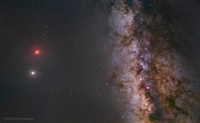Can someone please explain/confirm?
In the APOD 8/11/18
the eclipsed moon appears redder and roughly same apparent size as Mars. Is this because the image is composed of a series of different length exposures to cover a range of brightness?
Pretty but the image itself seems misleading, no?
If you hover over the image, Saturn, M8 and M20 are labeled but the moon and Mars are not. I am assuming red annular is moon and white is Mars.

Enjoy being online again!
Welcome to the community of good people who base their values on evidence and appreciate civil discourse - the social network you will enjoy.Create your free account
5 comments
Feel free to reply to any comment by clicking the "Reply" button.I did not follow this event, but I would assume the red is mars and the white is the moon. If I have any clue, which I may not, I would think the reason for the white to be the earth is that the earth is between the moon and the sun, thus the light could be focused on just a part of the moon making it look smaller, Then the red object could be the Moon as any light hitting it would be focused by the earth and having gone through the earth's atmosphere it would be red. I am almost sure none of this is correct, but it has been a good thought experiment.
Misleading indeed! This is what it actually looked like (2nd image):
[space.com]
You will never see the Moon and Mars being the same apparent size as long as you are on Earth. It's not physically possible - Mars would have to be within half a million miles of the Earth, and that's not going to happen. Yet every year there's a string of hoaxes running around the internet repeating the claims. The description at that link indicates that the photo is actually a mosaic, which explains why every object in the finished picture is the wrong size when compared to the other objects in the picture - different power eyepieces all[ow] them to take pictures of the objects so their sizes change..
I found a very similar reference: [apod.nasa.gov]
Explanation: Just two weeks ago, dark skies over the desert in northern Iran held this alluring celestial vista. The dramatic digital mosaic finds the Moon and Mars alongside the Milky Way's dusty rifts, stars, and nebulae. Captured through a series of exposures to cover a range in brightness, that night's otherwise Full Moon is immersed in Earth's shadow. It actually appears fainter and redder than the Red Planet itself during the widely watched total lunar eclipse. For cosmic tourists, the skyscape also includes the Lagoon (M8 ) and Trifid (M20) nebulae and planet Saturn shining against the Milky Way's pale starlight. The Moon isn't quite done with its shadow play, though. Today, the New Moon partially eclipses the Sun for much of northern planet Earth.
Not Found
The requested URL /apod/ap180811.html), was not found on this server.
Delete the ), from the end of the URL and it works fine.
Recent Visitors 34
Photos 424 More
Posted by starwatcher-alThe occultation of Mars on the 7th.
Posted by starwatcher-alThe occultation of Mars on the 7th.
Posted by starwatcher-alSolar minimum was in 2019 so the sun is ramping up in flares, spots and prominences.
Posted by starwatcher-alI missed the early phases of the eclipse but the clouds mostly left during totality. All in all a great eclipse. Next one is Nov. 8-22
Posted by starwatcher-alI missed the early phases of the eclipse but the clouds mostly left during totality. All in all a great eclipse. Next one is Nov. 8-22
Posted by RobecologyFor those following the JWST.
Posted by AnonySchmoose The post-launch set-up of the new James Webb telescope has gone very well.
Posted by HumanistJohnImages taken with Stellina (80 mm): M33 Triangulum Galaxy M1 Crab Nebula NGC281 Pacman Nebula in Cassiopeia NGC 6992 Veil Nebula in Cygnus
Posted by HumanistJohnImages taken with Stellina (80 mm): M33 Triangulum Galaxy M1 Crab Nebula NGC281 Pacman Nebula in Cassiopeia NGC 6992 Veil Nebula in Cygnus
Posted by HumanistJohnImages taken with Stellina (80 mm): M33 Triangulum Galaxy M1 Crab Nebula NGC281 Pacman Nebula in Cassiopeia NGC 6992 Veil Nebula in Cygnus
Posted by HumanistJohnImages taken with Stellina (80 mm): M33 Triangulum Galaxy M1 Crab Nebula NGC281 Pacman Nebula in Cassiopeia NGC 6992 Veil Nebula in Cygnus
Posted by HumanistJohnImages taken October 2nd 2021 with Stellina 1.
Posted by HumanistJohnImages taken October 2nd 2021 with Stellina 1.
Posted by HumanistJohnImages taken October 2nd 2021 with Stellina 1.
Posted by starwatcher-al Did you know that you can see Venus in the daytime?
Posted by starwatcher-alOne of these days I think that I'll figure out this Nikon.







